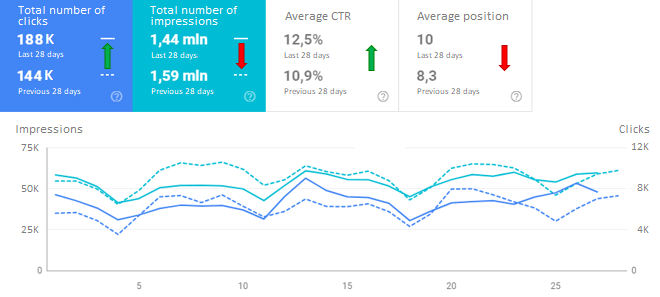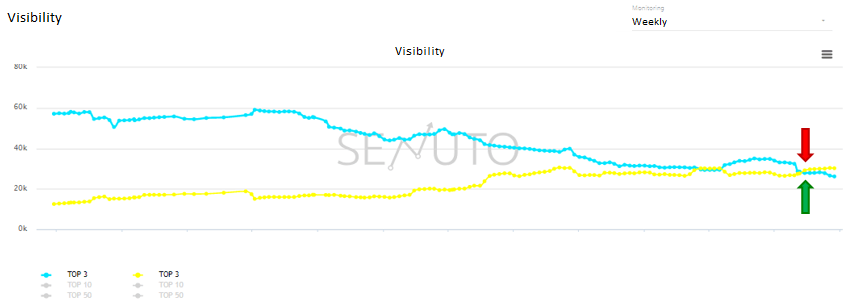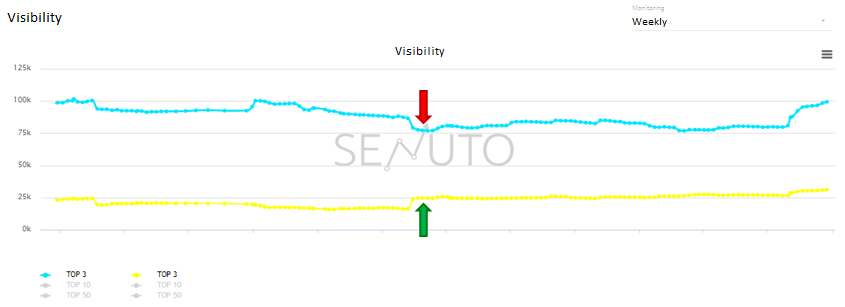When it comes to losses, people often panic at the very sound of this word. All of them – keyword positions, traffic or SEO visibility loss* – rattle both SEO specialists and clients. With good reason! If the success of your business hinges on those factors, all issues should be identified and eliminated on the spot. However, is falling SEO visibility always a cause for concern?
* SEO visibility – the number of phrases for which the website appears in organic search results (e.g. in top 3, top 10 or top 50).

SEO visibility loss: to worry or not to worry
For starters, it’s a good idea to identify phrases for which the website took a plunge. It often turns out that despite the lower position for a given keyword, organic traffic on the website has remained unchanged.
This may be the case if the keyword in question has never generated any substantial traffic. For example, if the website used to rank among the top 10 results in Google but was irrelevant to the queries, it has never constituted a valuable source of traffic.
The screen below shows the position of Allegro.pl for several keywords:

Assuming that users typing the word “interia” were looking for the website https://www.interia.pl/, the drop in Allegro.pl’s position for the phrase could have no effect on the traffic of the domain.
So before you rush into analyzing the causes of your falling SEO visibility, let’s see exactly which keywords took a dive. It may turn out that Google algorithm simply adjusted the search results for a group of phrases which failed to deliver traffic and, in some cases, were completely unrelated to the services offered.
The table below shows (daily or monthly) fluctuations in the position of certain phrases used on the Castorama.pl website but unrelated directly to the services of the store. The graphs suggest that despite the lack of strict optimization for those phrases, their use combined with the strength of the domain have sufficed to ensure Castorama.pl a high-ranking position in the search results:

How to check if SEO visibility losses have affected traffic?
It’s best to use two generally available tools: Google Search Console and Google Analytics.
Google Search Console lets you compare traffic for periods before and after the drop. It’s worth checking if the count of clicks to get to the website or to browse specific pages decreased together with the count of impressions or the average position of phrases. The example below shows that although some values dropped (number of impressions and average position), the traffic was actually growing.
Obviously, each case must be analyzed further for factors such as seasonality or changes in the level of interest in the brand.

It goes without saying that another useful tool for traffic analysis is Google Analytics, which also lets you compare periods from before and after a visibility loss. With Google Analytics, you can also check traffic on specific pages for which the position of keywords has sunk.
A juxtaposition of various data on your website gives you a better understanding of whether the shifts in phrase positions impact the number of visits. It may turn out that a visibility loss of the entire website or certain pages has had virtually no effect on the entire domain.
However, if an SEO visibility loss actually decreases your organic traffic, it’s not a bad idea to look into the situation and identify the issues that need solving.
Technical problems – why has your SEO visibility dropped?
There are many possible causes for an SEO visibility loss. Problems may be identified on some pages or even the whole website. Below you’ll find the most common technical irregularities found on websites.
-
Accidental removal from Google index
Accidental removal may be caused by a chunk of HTML code which eliminates the website from Google search results (https://support.google.com/webmasters/answer/93710?hl=pl).
Your website may be accidentally removed from Google index if you add the following tag in the HEAD section of your HTML code:
<meta name=“robots” content=“noindex”>
If your website used to be indexed but has recently disappeared, you’d better check if such a tag hasn’t found its way into the code.
-
Duplicate content
Duplication refers to a faithful and almost full repetition of the same content on two different webpages. There are two types of duplication: internal and external.
- Internal duplication – when the same content is presented by two different URLs of the same website, e.g. domain-name.com/womens-jacketsand www.domain-name.com/jackets-women. Given such a choice, Google robots may have trouble deciding which page to suggest to users in search results. In effect, the page may experience sudden shifts in positions for various phrases. The problem may be eliminated by redirecting the duplicated page to the correct one with the use of 301 Redirect or by adding a canonical tag to the correct page on the duplicated one (assuming that the existence of two identical pages has some practical application)
- External duplication – when you present the same content as an external website. Beyond a doubt, copying content from other domains is a worthless practice as it doesn’t help either the users or the SEO effort. Sometimes another, bigger website may steal your content and become its author in the eyes of Google robots. Unfortunately, if the owner of such a domain refuses to delete the stolen materials from their website, you may have no choice but to edit your own content.
-
Keyword cannibalization
Keyword cannibalization occurs when more than one page may answer the same query/the same phrase (pages are optimized for the same keyword).
For example, the phrase “women’s boots” was ascribed to three pages presenting varied products: www.domain-name.com/womens-boots, www.domain-name.com/womens-boots-for-fall and www.domain-name.com/womens-boots-for-winter.
Keyword cannibalization may cause unstable positions (sudden spikes and drops) and long-term slumps in organic search results. That is why, if possible, you should always select unique phrases for each page (Keyword Cannibalization is a useful tool for analysis, available in Senuto or Google Keyword Planner: https://adwords.google.com/ko/KeywordPlanner).
-
This page no longer exists
It you identified the page which took a plunge in search results, it may be a good idea to check if it… exists.
A deleted page returns error 404 which means that the server failed to find the resource (e.g. the URL has changed). If Google robots encounter a page which used to have content and high rank but now returns Error 404, they may stop presenting the page in question to users. It’s an adequate reaction – why would Google suggest a result which stopped providing any value?
The position may plummet also if the page returns Status Code 410 (which means that the resource has been permanently deleted). If you encounter such pages on your website, it’s useful to go over the possible causes of the error.
-
Erroneous redirects
Erroneous redirects occur if you redirect users to a page which is completely unrelated to the previous one or contains completely different content.
For instance, if a page X optimized for the phrase “women’s boots” will redirect users to “men’s shoes”, you can be quite certain that your website will stop ranking for the phrase “women’s boots”. Remember that the keyword must be strictly related to the content of your website. Otherwise Google may stop suggesting your pages to users who search sites relevant to their queries.
Increased activity of your competition
Website owners fight for the best positions for their businesses both in paid search and in organic results. Yes! Competition never sleeps. Take into account that as you search-engine optimize your website, your competition does not rest on their laurels, either.
Some sectors (like fashion, announcements, medicine) have thousands of competing domains so the race continues every day. Therefore, if the positions of your keywords have dropped even though you see no material issues on your website, let’s analyze who outperformed you and took your place in Google results.


What I mean by analysis is both the on-site analysis (optimization of content, range of your products/services, internal linking) and the off-site analysis (link building or other promotional activities). Possibly one of your competitors better optimized their product pages and categories… Or maybe they started a blog?
Check what your competitors are doing with the use of Senuto’s Competition Analysis tool.
Algorithm updates
When search-engine optimizing your website, you should always remember that Google may always tweak the algorithm, effectively wreaking havoc on the search results.
Algorithm updates are nothing but alterations in the assessment and classification of websites in the Google ranking. The importance of different factors may vary over time. Optimization for mobile devices, quality content, or page load time were all the talk of the town at some point.
Actually, if your website satisfies the needs of users, offers unique services or products, and doesn’t resort to SPAM, you should survive most updates safe and sound. However, sometimes even a reliable website with no technical flaws experiences an SEO visibility loss after an update. Should it come to that, follow the drill for competition analysis: see who outperformed you in search engine rankings and try to identify factors which caused the slump.
For more information on Google algorithm updates, see for instance: https://www.seroundtable.com/category/google-updates.
SEO visibility loss: Conclusions
There are dozens or hundreds of factors affecting the position of your website in search results. Keeping in mind that Google wants to suggest websites tailored exactly to the needs of users, you should prepare and optimize your websites accordingly.
It’s good practice to ask yourself about your potential expectations when typing a phrase in Google. If your website took a plunge in terms of position or broader SEO visibility, you should take a critical look at specific pages and the entire site. It may turn out that your product pages have poor descriptions or lack photos, that articles form an unreadable wall of text, your shop loads in 10 seconds, or that the crucial elements are all misaligned on mobile devices.
You should always divide your implementations on the website, starting with the critical ones and ending with the proverbial cherry on top. Continuous development and optimization of the website, both in terms of content and technology, gets you a better chance at leaving the competition far behind. It also helps you beat the odds against the never-ending updates of the Google algorithm. Even better: every update may actually give you an additional boost in the form of increased SEO visibility. Just make sure that your website proves its worth.
 Anna Antczak
Anna Antczak